About FERMA
An efficient transport sector is critical in a country’s socio-economic development. As one of the government agencies in the Nigerian transport sector, the Federal Roads Maintenance Agency [FERMA] is charged with the responsibility of maintaining over 32,000 kilometers of the federal roads. The agency was instituted to minimize the bureaucracies associated with road maintenance in the Federal Ministry of Works and Housing. The FERMA’s role entails undertaking simple road maintenance such as pothole patching, vegetation control, and asphalt re-laying (Olatunji and Diugwu, 2011). The agency has integrated a flat organizational structure that is headed by a Managing Director, who is assisted by six Executive Directors [EDs]. The EDs oversees the operation of the different departments. The agency has a total workforce of 1,300 employees. The employees include engineers, technicians, auditors, ICT staff, and administrators among many others. FERMA should integrate effective human resource management practices to achieve its goal. One of the HR practices that the Agency should consider entails performance appraisal.
Despite FERMA being an intervention to deal with the negative performance of the Federal Ministry of Works, the effectiveness of the agency is still questionable. Most roads in Nigeria under FERMA are in deplorable condition, which indicates poor employee performance (Olatunji and Diugwu, 2011).
Background to the study
Human resource is an indispensable element in organizations’ growth and sustainability. Thus, organizational managers should ensure that their workforce is competent coupled with having the relevant knowledge, attitude, and skills. Arthur (2008) insists that organizations must be concerned with sustaining the value of the employees’ skills, knowledge, and attitude to be competitive. One of the approaches that organizations can use in achieving this goal entails the integration of performance appraisal. According to the “Harvard Business School”, performance appraisal entails the process used by organizations in evaluating and supporting their workforce’s on-the-job performance (Authur, 2008, pg. 4). Alternatively, Sandler and Keefe affirm that performance appraisal mainly entails undertaking periodic reviews of how an organization’s workforce is performing relative to the set goals (Author, 2008. Pg53). Therefore, continuous assessment of the workforces’ performance is paramount in making the requisite alignment and re-alignment.
Any form of assessment forms the basis of ongoing learning, which is beneficial to both the employees and the organization. Subsequently, the employees’ capacity to adapt to the dynamic and complex work environment is improved (Bednall, Sanders, and Runhaar, 2014, pg.45). Ayers (2015, pg 170) further emphasizes that performance appraisal programs “can be used as a management tool for controlling organisational performance in”. Conducting performance appraisal gives organisational managers insight on how employees are undertaking their jobs. Arthur (2008, pg. 2) corroborates that performance appraisal increases the degree to which an organisation utilizes its workforces’ skills, interests, and knowledge.
Performance appraisal is classified amongst the fundamental human resource management functions. Both the private and public sectors are adopting performance appraisal in their strategic human resource management. Kirkpatrick (2006, pg. 20) stipulates that performance appraisal is critical in fostering a high level of accountability amongst the public servants. The “OECD” (2005, pg. 139) points out that most “government agencies utilize the appraisal results as basic data for the promotion and performance bonus”.
Problem statement
The effective application of the performance appraisal system can contribute to the improvement in an organization’s overall performance due to increased productivity from employees (Selvarajan and Cloniger2012, pg. 3063). Arthur (2008, pg. 3) further accentuates that effective application of performance appraisal goes beyond ensuring optimal utilization of human capital by fostering an environment for improved employer-employee relations, employee career development, and human resource development.
Despite its relevance to improving an organization’s long-term sustainability, the adoption of performance appraisal in both the public sector has been relatively low. The author affirms that some organizational managers have the perception of the process is time-consuming, non-productive, and difficult. Additionally, some managers fail to understand the connection between the employees’ commitment and effectiveness on the organization’s overall performance. Conversely, some employees perceive the process as a faultfinding undertaking that is aimed at justifying a firm’s decision not to promote employees.
Despite a company’s relatively low level of adoption, the value of performance appraisal cannot be underestimated. Farndale and Kelliher (2013, pg. 879) assert that the employment of performance appraisal provides an organization with an opportunity to improve its HRM strategies such as the reward strategy. The performance appraisal system must be designed effectively to enhance its value to an organization’s performance management approach. Kondarasuk (2011, pg. 61) argues that the absence of or implementation of an ineffectively designed appraisal system hinders an organization’s overall performance.
Aims and objectives
The purpose of this paper is to undertake a critical evaluation of performance appraisal in the context of an organization’s determination to foster the employees’ development. This purpose is achieved by conducting a case study on FERMA. The case study will provide a realistic understanding of how employees perceive the performance appraisal methods used by FERMA. Moreover, the case study will provide vital insight into the strengths and weaknesses of the performance appraisal at FERMA. The study will focus on the following objectives to achieve this goal
- To assess critically the perception of subordinate employees on performance appraisal program at FERMA.
- To undertake extensive scrutiny on the strengths and weaknesses of the performance appraisal program used by FERMA
- To critically assess the goals and outcome of performance appraisal in FERMA on employees at the management and subordinate levels
- To examine critically the gaps in the efficacy of the current performance appraisal program in structure and purpose regarding best practices and organizational context.
Research questions
The following research questions were taken into account to achieve the above objectives.
- What is the perception of subordinate employees on the performance appraisal program at FERMA?
- What are the strengths and weaknesses of the performance appraisal program used by FERMA?
- What are the goals and outcome of performance appraisal in FERMA on employees at the management and subordinate levels?
- What are the gaps in the efficacy of the current performance appraisal program in structure and purpose regarding best practices and organizational context?
Significance of the study
The findings of the study will be of significant importance to organizations in Nigeria due to several factors. First, the study will enhance the view of performance and lead to its appreciation as a productivity tool for firms. Secondly, the study will result in the improved structuring of performance appraisal amongst organizations. Moreover, the study will provide managerial practitioners insight on how they can apply performance appraisal to maximize the value of their human resources.
Limitation of the study
Due to the scarcity of resources about time and finances, it was not possible to conduct the study on all employees at FERMA. Therefore, to deal with this challenge, the study was based on the concept of sampling. Subsequently, it is assumed that the selected respondents will be representative of the prevailing situation regarding the employees’ performance at FERMA.
Literature Review
Introduction
Chapter 1 highlights performance appraisal as a fundamental strategic human resource management practice that organizations should adopt in their quest to promote their performance. This chapter involves a critical review of past literature on performance appraisal. The significance of this chapter is to identify gaps and areas of improvement concerning performance management. The chapter is organized into several sections. Section 1 entails a review of the application of performance appraisal at FERMA in Nigeria. Thus, this subsection identifies the areas in which FERMA has erred in implementing performance appraisal. This goal is achieved by taking into consideration the research objectives. The second subsection entails an evaluation of the critical issues that organizations should take into account in designing an effective performance appraisal system. The analysis in the two subsections provides insight into the critical issues that FERMA should take into consideration in using the performance appraisal system as a tool for promoting organizational and employee development. Therefore, sections will form the basis upon which the study draws recommendations on the critical aspects that FERMA should integrate the necessary corrective measures. Therefore, the review will enhance the contribution of the dissertation to FERMA’s development.
Evaluation of performance appraisal at FERMA
Agbola and Abena (2011, p. 82) affirm that performance appraisal comprises a fundamental strategic technique in an organizations’ quest to maximize the value of their human capital. Despite the efforts by the huge budgetary allocation, Ogunleye (2013, p 12) emphasizes that a significant proportion of roads in Nigeria is in deplorable conditions hence making road transport unsafe and slow. This aspect indicates the existence of inefficiency in the FERMA’s approach in executing its road maintenance and monitoring role. One of the factors that might have triggered this situation at FERMA is the lack of employee commitment towards the attainment of the overall organizational goals.
The quality of an organization’s working environment is correlated directly with the level of the employees’ commitment. The performance appraisal programs should be designed in such a way that they address the employees’ individual development needs. This goal can be achieved if an organization integrates the necessary competency development and training initiatives. Bhattacharyya (2011, p.57) asserts that individual employee development is greatly enhanced by the feedback obtained from the performance appraisal process.
Developing employee commitment is an essential human resource management role that managers must ensure. However, the attainment of this goal is influenced by human resource management practices adopted by an organization. Effective integration of the performance appraisal process constitutes one of the fundamental aspects of promoting employee commitment. The performance appraisal system should be employee-centric, which means that it should not only be a checklist on the ‘dos’ and ‘don’ts’. On the contrary, organizations should be a basis through which an organization undertakes a wider understanding of the employees (Qureshi and Hassan, 2013, p. 60). Thus, the performance appraisal process should enable employees to understand the firm’s commitment to their development. Employees have personal and career development goals when joining an organization and intend the firm to facilitate their attainment (Falcone and Tan, 2013, p. 45).
The performance appraisal system should ensure that employees are aligned with the organizations’ goals and mission. Agbola and Abena (2011, p.82) maintain that performance appraisal “is a strategic tool to link employee activities with the organization’s mission and goals by identifying results and behavior needed to achieve the organization’s goals”. In line with its commitment to deliver its mandate, FERMA has integrated a performance checklist that focuses on several areas. The checklist is comprised of a set of standards that employees are required to observe to achieve exceptional performance. Secondly, the criteria assert that employees must be actively engaged with other staff members in undertaking their duties. The third aspect highlights the importance of being fair, developing a committed workforce, and continuously improving its performance.
The current performance appraisal system at FERMA is ineffective in ensuring that the public servants working within the agency understand and are committed to the attainment of the Agencies goals and vision. It is part of our objectives in this research to scrutinize the strengths and weaknesses of the performance appraisal program used by the Agency. A Public Service Charter guides the Agencies operations. Article 21 of the Charter emphasizes that the employees should depict a high level of professionalism in their service to enhance their output. Despite the formulation and implementation of a comprehensive performance charter in evaluating employee performance, the Agency’s appraisal system is weak in that it is not aligned with the employees’ personal and career development goals. Thus, its efficiency in promoting the creation of positive perception amongst the employees is limited.
Goal alignment is a critical component in promoting organizational performance. The likelihood of employees performing at an optimum level is considerably higher if they accept challenging goals as compared to less complex goals. Moreover, the job roles and responsibilities must contribute to personal development and career progression (Arthur, 2008, p. 142). The relevance of goal alignment is further underscored by the goal-setting theories (Ayers, 2015, p. 171). The goal-setting theory stipulates the importance of establishing an effective feedback mechanism that illustrates the goal-to-performance relationship (Latham, 2013, p. 334). Thus, the lack of goal alignment has limited the Agencies’ performance appraisal program capacity to contribute to improving its performance management practices.
The effectiveness of the performance appraisal system is further determined by the performance appraisal process. The performance appraisal process should further be comprised of an effective performance feedback process. Furnishing employees with performance feedback improves their understanding of how their activities contribute or fail to enhance the achievement of the organizational goals. Thus, it can contribute to improvement in employee performance. The feedback mechanism should be based on an extensive discussion with the employees.
In conducting the employee appraisal, FERMA needs to consider undertaking a comprehensive discussion with the employees. The discussion should be aimed at identifying the employees’ performance problems. This approach enables organizations to be effective in designing employee development programs such as the need-based training (Bhattacharyya, 2011, p. 57). Implementing need-based training based on the performance appraisal contributes to renewed knowledge and skills. Therefore, one can argue that performance appraisals are fundamental in ensuring that an organization integrates programs that amount to the employees’ personal development. Furthermore, organizational leaders should be conscious of the importance of nurturing positive job behavior amongst their workforce (ibid.).
Qureshi and Hassan (2013, p. 66) assert that the performance appraisal process should contribute to the formulation of effective human resource management decisions. Thus, the performance appraisal process should be effectively designed to evaluate ‘within-individual’ and ‘between individual’ performances. The ‘between individual’ performance evaluation seeks to gather the information that would improve decision making on issues such as salary increment, employee demotion, promotion, or transfer. The current performance system at FERMA has not factored in the evaluation of ‘between individual’ performance. This situation is well illustrated by the assertion by some of its members at Akwa Ibom and Cross River states. The staff members affirm that they have been receiving salaries without doing any work (Charles, 2015). This aspect illustrates that the company has not tied the employees’ pay to performance, which is a major weakness in the company’s appraisal system. Moreover, the failure to link employee pay to performance indicates the existence of a remarkable gap in the organization’s performance appraisal system.
Conversely, ‘within-individual’ performance evaluation aids in determining the employee’s training and development needs (Qureshi and Hassan, 2013, p. 60). FERMA must ensure that the employees perceive the performance appraisal program adopted by a firm to be valuable and, as part of the objective of this dissertation; we will try to establish whether this is the case by critically assessing the employees’ responses to our questionnaire and interviews. This aspect means that the program should be designed in such a way that it incorporates issues related to the employee’s personal and career development needs. The current performance appraisal system at FERMA has not clearly defined the Agencies commitment towards promoting employee development. Subsequently, the agency is experiencing an increase in the rate of employee turnover. The high turnover has arisen from the development of a negative employee perception on the chances of attaining personal development and career goals. In redesigning the performance appraisal system, FERMA must focus on ensuring that the system contributes to the evaluation of ‘between individual’ and ‘within individual’ performances. This approach will improve the capacity with which the firm utilizes the performance appraisal system as an employee personal and career development tool hence promoting their level of commitment to the organization and productivity (Selvarajan and Cloniger 2013, p. 3064).
Considering the existence of redundancy at FERMA, the organization’s management team must ensure that the performance appraisal systems contribute to the entrenchment of justice in the performance appraisal system. This goal can be achieved by integrating fairness (Bhattacharyya, 2011, p. 55). Selvarajan and Cloninger (op. cit.) emphasize that organizations should be concerned with integrating procedural justice, for example, by entrenching accuracy and fairness in the appraisal system. The concept of fairness should be entrenched by eliminating errors such as rater bias. Integrating this approach is essential in ensuring that the performance appraisal system is effective by identifying the specific areas in which the employees are deficient in their performance.
Armed with the above theoretical insight about FERMA’s performance appraisal system, as one of the objectives of this work, we will use the responses we will get from the employees to examine the gaps in the efficacy of the current appraisal program in structure and purpose regarding best practices and the organizational context.
Performance appraisal systems
The process of employee appraisal has become a basis for evaluating the employees’ strengths and weaknesses over the past few decades. Its relevance arises from its contribution to an employee and organizational development. The performance results provide managers insight on how to increase productivity (Bhattacharyya, 2011, p. 57). To succeed in developing an effective performance appraisal system, HR managers need to integrate the best performance appraisal practices. If the performance appraisal system adopted by an organization does not meet this objective, the management team must undertake an extensive re-look on the defective appraisal aspects. For example, if the appraisal system is linked to rewards and only a small proportion of employees are rewarded, the employees who are not rewarded may be de-motivated (ibid. p. 55). On the contrary, the performance appraisal process should be fair and equitably administered. Moreover, it should illustrate the organization’s commitment to meeting employee expectations.
The existing performance appraisal system indicates the prevalence of remarkable gaps. Thus, the organization should take into account several issues in designing and using a performance appraisal framework. Armstrong (2009, p. 67) identifies different issues that organizational managers should consider as a way of becoming effective in performance appraisal. First, the appraisal system should be based on a well-formulated policy. The purpose of the policy is to ensure that the expectations, roles, and competencies necessary for attaining the desired level of performance are stipulated clearly. The policy should not only be used as a benchmark for assessing whether the employees have achieved the desired level of performance. Conversely, it should be used as a human resource management decision tool. For example, the performance appraisal system should involve a systematic approach to gathering evaluation information regarding job contents (Mello, 2014, p. 525). Consideration of this information will improve the performance appraisal system’s effectiveness in its job redesign process hence improving the value of the job to employees’ development.
The appraisal system should be aligned with the stipulated departmental and organizational objectives. The individuals charged with the responsibility of undertaking the performance appraisal should be trained effectively to eliminate the occurrence of negative aspects such as bias. The performance appraisal process should be based on a comprehensive set of standards. Some scholars criticize the adoption of evaluative performance appraisal arguing that it might lead to the reduction in the employees’ level of commitment and relationship amongst employees. Mello (ibid.) argues that the lack of predetermined performance standards increases the chances of the individuals charged with the responsibility of overseeing the appraisal process making subjective guesses or developing feelings that might harm the process. Therefore, the firm should ensure that the appraisal process is accepted by the employees by ensuring that it is not subjective.
In addition to the above aspects, the process of appraising the employees’ performance should be based on individual targets. The purpose of setting such targets is to ensure that the employees’ evaluation, departmental, and employee goals are aligned with the overall organizational goal. The organization should further ensure that regular monitoring of the employees’ performance is undertaken (French, 2011, p. 80). This assertion means that performance appraisal should not be confined to an annual formal HR event. On the contrary, the appraisals should be undertaken continuously to identify gaps in the employees’ performance. This approach increases the likelihood with which an organization integrates prompt corrective actions. In undertaking performance appraisal, organizations should gauge the employee’s actual performance against the set targets. This approach is critical in ensuring that an organization succeeds in evaluating the effectiveness with which employees accomplish the assigned roles (Kirkpatrick, 2006, p. 47). Moreover, integrating this approach enhances an organization’s efficiency in measuring performance outcomes that are difficult to quantify.
The effectiveness of the performance appraisal system is influenced by the extent to which an organization has appreciated the communication. The importance of communication arises from the view that it aids in enhancing the value of performance appraisal by sharing information on employee performance. Kirkpatrick (ibid.) asserts that communication makes employees understand the expectations of the appraisal. Moreover, communicating the purpose of the appraisal makes employees develop a feeling of involvement in the appraisal of their job performance. Armstrong (op. cit., 98) emphasizes that goals and feedback should be incorporated into the appraisal process to achieve the desired accomplishment.
The communication process should not only be limited to the purpose of performance appraisal. On the contrary, it should also entail the provision of feedback on the outcome of the appraisal. According to (ibid., p. 101), organizations should ensure that communication on performance appraisal is based on evidence (101). The process of providing feedback should entail informing employees about the results of the performance appraisal, the critical incidents identified, and significant behaviors. Furthermore, the feedback should involve commending employees for exemplary performance, provide insight on how employees can improve their performance, and inform them of where they have performed dismally (ibid., p. 105). Consequently, in the process of undertaking performance appraisal on its employees, FERMA should ensure that it bases its employees’ motivation approaches on the gathered evidence. This aspect is essential in making relevant adjustments aimed at improving the employee’s performance and productivity.
The available literature shows that the data obtained from the performance appraisal can be used in making managerial decisions relating to different such as salary administration, employee promotion, retention, and termination (Lyster and Arthur, 2007, p. 56). In its quest to use performance appraisal as a tool for employee and organizational development, FERMA must ensure that the data is not used negatively. Agbola and Abena (2011, p. 87) maintain that despite the benefits that can be derived from performance appraisal, some managers might use it to victimize employees. For example, some managers might use appraisal ratings to coerce and dismiss some employees such as union members and sympathizers. Additionally, some managers may use doctored appraisal results to promote certain people, which is against fairness and merit. Therefore, if FERMA intends to use performance appraisal as a tool for organizational and employee development, the firm must use the data fairly and accurately.
Limitations of the literature review
The review of literature is limited to two main concepts of performance management, which include performance appraisal and the implementation of a performance appraisal system. However, the review has not evaluated the plan or approach that firms such as FERMA should follow in implementing a performance appraisal system.
Conclusion
Based on this preliminary research, we could understand the Performance Appraisal System at FERMA is ineffective in ensuring that the employees understand the Agency’s goals and vision, hence the need to scrutinize the strengths and weaknesses of the system. This ineffectiveness could also be seen in the slow pace at which projects are executed at the Agency, which is likely caused by the lack of motivation of the FERMA employees. This informs the need to study and analyze the Performance Appraisal system of FERMA in this dissertation to recommend the best ways to develop the employees and the Agency as a whole through the use of performance appraisal. The Agency must ensure that the employees perceive the performance appraisal to be a valuable one, and it is an objective of this dissertation to assess what their perception of the system is. We have also established that a Performance Appraisal System must have a goal and some expected outcomes, hence, this dissertation would assess the goals and outcomes of FERMA’s current appraisal program. This will enable us to examine the gaps in the efficacy of the current appraisal program in structure and purpose regarding best practices and the organizational context.
Furthermore, different themes can be identified from the literature review. One of the major themes relates to employee performance. The effectiveness of performance appraisal in promoting employee development depends on whether it forms the basis of managerial decisions on issues such as employee training. Poorly designed appraisal systems might not be valuable in an organization’s quest to enhance the employees’ and organizational performance. The behavior and attitude of employees in the workplace are subject to their perception of the HR practices adopted by the firm. Subsequently, employees may react differently to the application of a performance appraisal system. The organization must ensure that employees understand that the performance appraisal system is intended at enhancing their personal and organizational development rather than punish them.
Methodology
Research methods and justification
The purpose of this research study is to examine how FERMA can implement performance appraisal as an employee and organizational development tool. The study’s rationale is based on the recognition of the value of employees in promoting long-term organizational success. The work intends to achieve this goal by evaluating the strengths and gaps in the company’s current performance appraisal program. The evaluation will provide insight into the fundamental strategic management issues that the firm should integrate with improving its approach to performance appraisal. The study can be defined as qualitative due to its exploratory nature. Thus, it will lead to the discovery of new ideas and insight regarding the problem under examination (Majumdar, 2011, p. 3). This chapter details the methodological approaches that will be taken into account in conducting the research study.
Research design and justification
To achieve the research objective, the study will be based on a simple descriptive research design. The rationale of the descriptive research design is to develop a comprehensive description of the state of affairs at FERMA. Tappen (2011, p.70) emphasizes that ‘simple descriptive design focuses on a single group or population’. The effectiveness of the descriptive research design will be enhanced by incorporating the case study and descriptive survey research approaches.
By integrating the case study research design, it will be possible to undertake a comprehensive understanding of the gaps and strengths in the prevailing performance program at FERMA. The case study research design will ensure that the specific components of the firm’s performance appraisal process are evaluated. The case study design will further lead to the development of an extensive understanding of the possible aspects that the Agency should focus on improving the performance appraisal process. Subsequently, the integration of the case study design will aid in refining the performance appraisal at FERMA. Thus, the effectiveness of the performance appraisal as a tool of fostering employee and organizational development will be improved remarkably.
Alternatively, the descriptive survey design will improve the ease with which the requisite research data is collected. Hepper et al. (2015, p. 289) stipulate that a descriptive survey design contributes to the development of self-report on a particular subject. The application of the descriptive research design will enable the researcher to understand FERMA’s opinions, habits, and attitudes towards the current performance appraisal program. Moreover, Hepper et al. (ibid.) stipulate that ‘survey research involves studying the patterns, causes and effects of issues within a certain population’. Thus, the survey design will increase the chance of identifying facts on the issue being studied.
Target population and sampling
Selection of the research site is essential because it influences the usefulness of the information produced from the study. The study’s target population will be comprised of employees working at different departments in FERMA Nigeria. The choice of employees from different departments as the research respondents will aid in obtaining varied and credible data on FERMA’s performance appraisal process. The choice of this target population will aid in entrenching the concept of diversity in the construction of the sample study. Thus, the study will successfully identify the perception of different levels of employees on the prevailing performance appraisal system. Therefore, consideration of diversity in selecting the respondents will contribute to effective knowledge creation.
The inclusion of all the Agency’s employees in the study is not feasible because of resource constraints such as time and finances. To overcome the resource constraint challenge, the study will be based on the simple random sampling technique. This technique will aid in constructing the sample study. Considering that a large workforce facilitates FERMA’s operations, a sample of 20 employees will be selected. Furthermore, the simple random sampling technique will aid in the construction of representative sample size by eliminating subjectivity. This will improve the effectiveness with which the research findings are generalized to the entire organization.
Data collection
The research data will be obtained from primary sources. The justification to obtain data from primary sources has arisen from the need to increase the credibility of the research findings. The primary sources will ensure that the research data is collected from the real environment. Therefore, based on the primary data, the reliability of the study’s findings will be improved. However, it will be ensured that the data collected is relevant and realistic.
To ensure that sufficient and reliable data is collected from the primary sources, the study will be based on the data triangulation approach. Crowther and Lancaster (2012) define data triangulation as the process of obtaining data from different sources in conducting a particular research study. The researcher will ensure that the three main dimensions of data triangulation, which include time, person, and space triangulations, are incorporated. Time triangulation will be achieved by ensuring that the research data is collected at different points in time. Thus, it will be possible to obtain data from the targeted sources by eliminating inconveniences associated with a lack of limited time. Alternatively, space triangulation will entail collected data from different units at FERMA. This aspect will aid in gaining insight into the overall employee opinion regarding the implemented performance appraisal program at FERMA. Conversely, person triangulation ensures that the study focuses on different individuals within an organization. In this case, person triangulation will enable the researcher to gather the opinion of employees at different levels of management within FERMA on the application of performance appraisal.
To enhance the efficiency of the data collection process, the study will employ effective data collection techniques and instruments that include questionnaires and interviews. A comprehensive set of questionnaires will be developed to collect the required data. The questionnaires will specifically be based on the research objectives. In designing the questionnaires, the researcher will incorporate semi-structured questionnaires. Thus, open and close-ended questionnaires will be developed. The close-ended questionnaires will aid in gathering specific response regarding the research topic. Conversely, the open-ended questionnaires will aid in understanding different issues regarding the performance appraisal process such as the strengths and weakness of the performance appraisal and the employees’ perception of the prevailing performance appraisal program at FERMA. Comprehensive scrutiny of the questionnaires will be undertaken to eliminate grammatical errors and ambiguity hence improving the rate of response (Remenyi 2012).
To ensure that the data is efficiently collected, the research will integrate the survey monkey as one of the core data collection instruments. The SurveyMonkey is a software that enables researchers to conduct online surveys efficiently and effectively in disciplines such as management and marketing. The survey software will improve the ease with which research questionnaires are developed and distributed to the respondents. By using the survey monkey as a data collection instrument, it will be possible to distribute the questionnaires through iOS and Android enabled mobile applications. Furthermore, the monkey survey software provides the researcher options on whether to distribute the questionnaire through the web or social media network.
The data collection process will further employ the interviewing technique, which will be operationalized by incorporating the conducting a telephone interview on five officers selected from FERMA’s top management team. The rationale for adopting the interviewing technique is founded on the need to gather relevant research data (Connaway& Powell 2010). Thus, interviewing the five officers will enable the researcher to gather critical information on performance appraisal at FERMA. Conducting telephone interviews and integrating survey monkey will significantly minimize the cost of the study. By incorporating the interviewing technique, the researcher will be in a position to understand the general attitude and perception regarding the prevailing performance appraisal program (Remenyi 2012).
Data analysis and presentation
To improve the value of the data collected, the study will integrate both quantitative and qualitative data analysis techniques. Qualitative data analysis will be achieved by incorporating the rating technique. Thus, the Likert scale will be used in evaluating the descriptive data gathered. The Likert scale will aid in analyzing the qualitative data collected from the field. Therefore, a 5-point Likert scale will be developed to gather the respondents’ opinions on the research topic such as the strength of the current performance appraisal system at FERMA. Furthermore, the data collected will be presented using tables, charts, and graphs. This aspect will improve the ease of understanding and interpretation of the data collected by different parties within the firm. Thus, the relevance of the study to the organization’s management team will be improved.
Ethical considerations
The process of conducting this study involves interaction with human beings during the data collection process. Thus, to guarantee that the data is collected effectively and efficiently, the researcher will ensure that the requisite ethical considerations are taken into account. One of the fundamental ethical considerations involves establishing rapport with the respondents. The credibility of the study’s results will depend on the quality of answers given by the participants. Before the actual research survey, the researcher will seek permission from FERMA’s management team. This aspect will aid in minimizing the perception of the research study being intrusive on the firm’s management practices. Furthermore, seeking permission will increase the ease of credible and relevant data on FERMA’s performance appraisal program. The researcher will ensure that the selected respondents understand that the study is for academic purposes.
To increase the rate of participation in the study, the researcher will assure the respondents of the confidentiality of the information provided through the questionnaire. The participants’ confidentiality is one of the requirements of any research work. In addition to the above aspects, the researcher will ensure that the respondents are respected during the entire data gathering process. This goal will be achieved by taking into consideration two main dimensions. First, the researcher will ensure that the respondents’ participation in the research study is not achieved through coercion. Secondly, the respondents will be provided the right to pull out of the research study without any consequences.
Limitations
The study is not free from limitations. First, the research study primarily focuses on the performance appraisal system and process at FERMA. The study does not emphasize how the firm can use other HR practices in promoting employee and organizational development. Therefore, the findings of the study are not conclusive on the firm can promote employee development.
Furthermore, the process of undertaking the research study might be hindered by limitations arising from resource constraints, time, and finances. However, this limitation is expected to be resolved using the simple random sampling technique. The simple random sampling technique will aid in minimizing the cost of the study. Subsequently, it is assumed that the selected sample is representative hence increasing the ease of generalization of the research findings.
Results and Discussion
Introduction
The application of the descriptive research design in the study has led to the generation of sufficient data on the application of performance appraisal as a tool for promoting employee development at FERMA. Subsequently, the data has provided remarkable insight into the effectiveness of the firm’s performance appraisal system. This chapter presents the results and discussion of the study’s findings. The study is organized into three sections that include the presentation of the respondents’ descriptive statistics, analysis of the research questions and discussion, and the conclusion.
Presentation of the respondents’ descriptive characteristics
The study focuses on gaining extensive insight into the application of performance appraisal at FERMA. The research has gathered data from both genders. However, the level of participation across the two genders differs as illustrated by graph 1 below. Twenty [20] of the 22 respondents completed the survey, which makes the completion rate to be 91%.
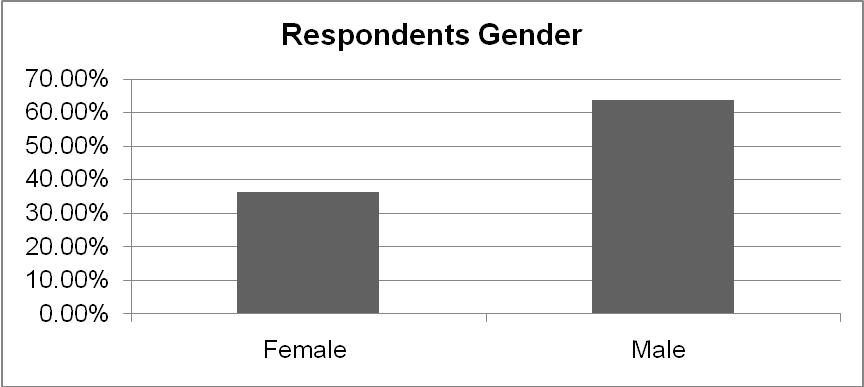
The respondent’s marital status varied as indicated by graph 2 below.
Table 1.
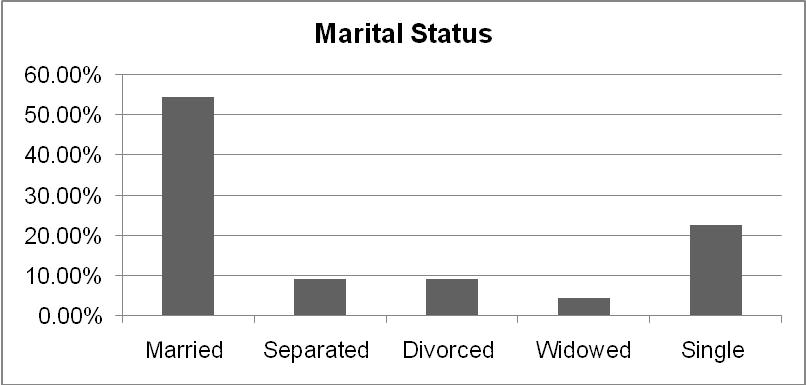
The respondents’ educational background differs substantially as indicated by table 2 and graph 3 below.
Table 2.
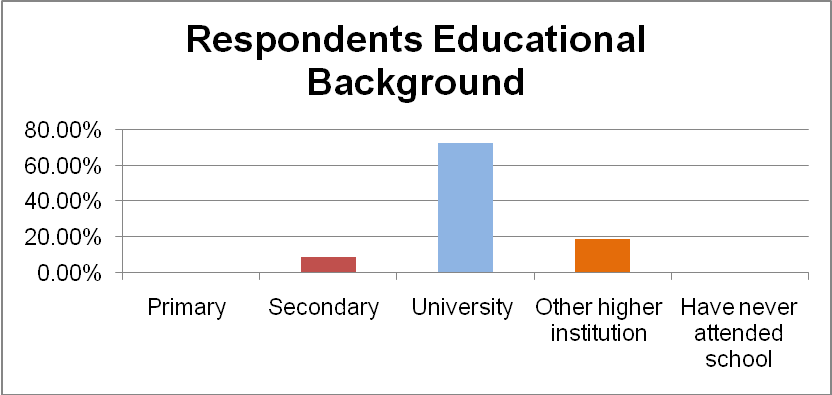
Analysis of research questions and discussion
The study sought to gain data that would provide insight into the research questions posed. All the study’s respondents (100%) affirmed that FERMA has incorporated performance appraisal as one of its human resource management techniques. This aspect highlights that the firm is conversant on the contribution of the performance appraisal program in the pursuit to achieve competitiveness concerning human capital. Moreover, the firm values the performance appraisal system as one of the components that can contribute to improvement in the quality of the firm’s Human Resource Management. Aggarwal and Thakur (2013, p. 617) corroborate that ‘properly designed and realised process of the employees’ appraisal is not only the necessary basis for a successful employee performance management but also provides valuable information for other human resource management functions’.
In spite of FERMA’s integration of performance appraisal, the study indicates existence of remarkable gaps. Aggarwal and Thakur (2013) are of the view that successful implementation o the performance appraisal technique improves an organisation’s capacity to make decisions related to employee training and development, validation of employee selection process, layoff decisions, transfers and promotion, human resource planning, development of interpersonal relationships and career development (Aggarwal & Thakur 2013). In spite of formulating the performance appraisal policy, the application of the technique has been ineffective as underscored by the limited utilisation of the tool in understanding the employees’ level of performance.
The data gathered to illustrate the existence of significant variation amongst the employee’s understanding of the application of performance appraisal at FERMA. FERMA employees have developed varied perceptions of the application of the performance appraisal program within the firm. Seventy-five percent (75%) of the respondents think that the firm has integrated a policy outlining how it can leverage performance appraisal in enhancing the level of organizational and employee development as indicated by graph 4.
Table 3.
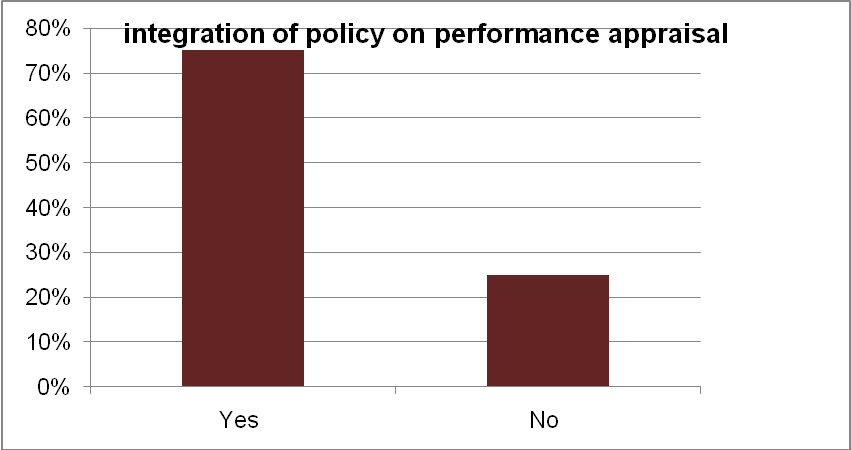
Graph 4 shows that 75% of employees are conversant with the presence of a performance appraisal program within the firm. Integration of performance appraisal policy is fundamental in the successful entrenchment of the performance appraisal program within a firm. The performance appraisal policy stipulates the guidelines that organizational managers and supervisors should follow in conducting a performance appraisal. Some of the vital elements that FERMA should ensure in its policy entails outlining the schedule on when to conduct the performance appraisal, the stipulation of the party responsible to foresee the appraisal process, how the performance appraisal will be used in adjusting employee compensation, and how the appraisal will be undertaken (Vallabhaneni 2013). The consideration of these elements will ensure that the performance appraisal policy is valuable to the organization’s focus on employee and organizational development.
Despite the employees’ knowledge of the presence of performance appraisal policy, 44% of the respondents are of the perception that the firm has not attached value to understanding the employees’ level of performance in its strategic human resource management practices. Only 19% of the respondents are conversant on how FERMA values the understanding of the employees’ performance. This aspect indicates a remarkable gap in the application of the performance appraisal program. This explains why the firm continues to experience a high rate of employee turnover.
One of the factors that have led to this situation entails a limited chance of the firm using the performance appraisal in promoting the employee’s personal and career progression.
Hernadez (2010) affirms that the essence of incorporating the performance appraisal program in an organization is to use it as a tool for improving its strategic human resource management practices. This goal can be achieved by developing an extensive understanding of the employees’ performance level. Subsequently, FERMA should consider the most appropriate way of using the performance appraisal system as a source of intelligence on human resource management. Mathis and Jackson (2008, pg. 120) support this view by affirming that ‘performance data on productivity, employee relations, job knowledge, and other relevant dimensions can be gathered through performance assessment’.
Organizational managers must develop an extensive understanding of the employees’ workplace behaviour and level of satisfaction. The performance appraisal program tool can aid towards achieving this end. However, the study’s findings shows that the FERMA’s top management is not concerned with understanding the employees’ performance, productivity, and satisfaction. Subsequently, the firm is characterized by a high rate of voluntary employee turnover, hence undermining its long-term sustainability.
According to table 4, FERMA has not attached the importance of understanding the employees’ performance. The firm should consider using the performance appraisal as a tool for promoting a performance by entrenching HR aspects that contribute to improvement in employee level of satisfaction and productivity. Some of the essential aspects that the firm should consider entailing job enlargement and job enrichment (Hernandez (2010) affirms that employers are liable for bad behavior within the workplace especially if it influences the performance of other employees.
Table 4.
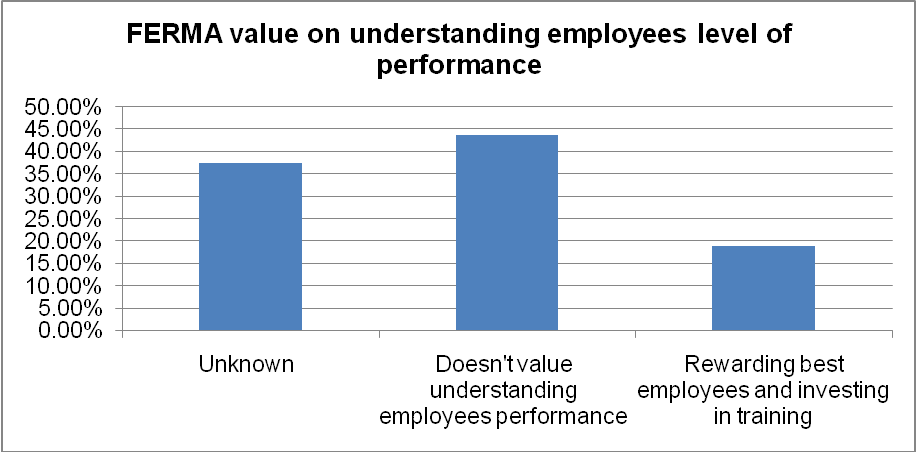
The study’s findings further indicate the existence of a limited understanding of the importance of integrating key performance drivers in stimulating employee performance. Table 5 below indicates some of the key performance drivers according to the respondents.
Table 5.
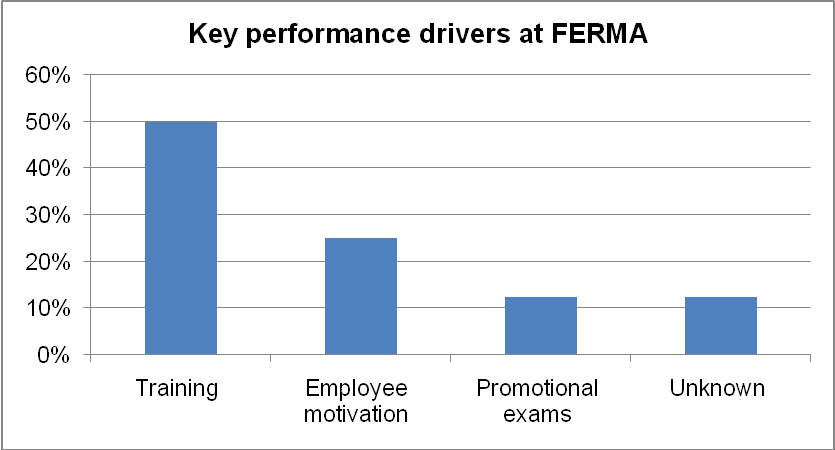
Performance drivers are essential in an organization’s quest to achieve performance excellence. Bussin (2012) posits that it is not sufficient for an organization to formulate the goals and missions to be attained. However, the identification and inclusion of the most valuable drivers are essential. Organization managers should identify at least three measurable drivers to be used in promoting employee performance. Graph 5 indicates that a significant proportion (50%) of employees at FERMA appreciate training as a critical performance driver that the firm has entrenched in its quest to leverage on the performance appraisal program.
The International Management Association (2012) stipulates that employee productivity is influenced by different performance drivers such as employee training and the provision of autonomy in making workplace decisions. However, the firm is characterized by gaps in implementing and entrenching key performance drivers because of overemphasis on employee training. To leverage on the key performance indicators, FERMA should consider establishing a balance on the diverse performance drivers such as employee motivation through the integration of an extensive reward system. This approach will improve the firm’s efficiency in using key performance drivers as a tool for promoting employee development and organizational sustainability.
The study shows that FERMA has largely relied on the ranking and rating methods of performance appraisal. Fifty-five percent (55%) of the respondents identified ranking as one of the most prominent methods that FERMA uses in evaluating employees while 25% of the residents cited the rating technique. Conversely, 20% of the respondents indicated the existence of other methods as illustrated by graph 6 below.
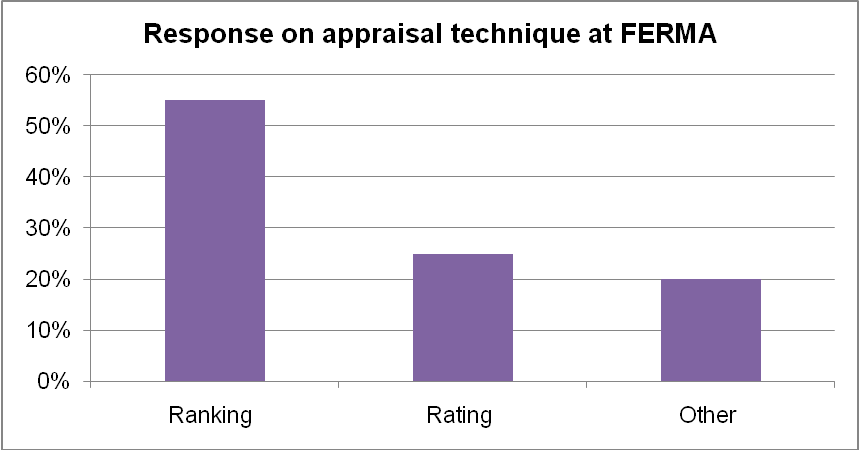
One of the benefits that FERMA can achieve by entrenching the merit rating appraisal technique, viz. rating, and ranking, is that the firm can undertake a more specific and formalized performance appraisal. This aspect emanates from the fact that the merit rating technique relies on a predetermined criterion that serves as the performance appraisal standard. The incorporation of the merit rating technique provides room for comparison on the performance of employees within a specific category. Schultz and Schultz (2015) accentuate that the merit rating technique enables a firm to undertake an objective performance appraisal. The implementation of the rating technique can be achieved by formulating a performance rating scale that the supervisor used is in specifying the degree to which an employee possesses the stipulated job characteristics. The rating can be poor, average, or excellent.
FERMA’s overreliance on the ranking technique is one of the aspects that make its performance appraisal process weak. The firm should not over-rely on one rating technique. On the contrary, the firm should consider integrating diverse rating and performance appraisal techniques. This approach will aid in capturing different aspects that influence employee performance such as workplace behavior. Examples of such behaviors relate to time management, attendance, cooperation, initiative, judgment, and supervisory capabilities. Alternatively, the firm can rate the employees by gauging the current performance results with the historical performance results (Aggarwal & Thakur 2013). Through this approach, FERMA will successfully determine whether the employees’ performance has improved or declined. Although the rating technique is easy to formulate and use, it is substantially difficult to eliminate bias. This aspect means that the performance appraisal results might be characterized by the ‘rater’s’ personal bias hence limiting their relevance to the organization’s pursuit for organizational and employee development.
The limitations associated with the rating and the ranking techniques are integrated to highlight the need for the firm to adjust the rating technique. One of the most important techniques that the firm should consider involves the behaviorally anchored rating scale (BARS). Effective incorporation of this technique will contribute to remarkable improvement in the value of the performance appraisal program in the attainment of the employee and organizational development goals. Through this technique, FERMA will successfully evaluate the employees’ job performance based on specific behaviour that the firm considers critical in achieving these goals. Nevertheless, successful implementation of the BARS technique requires a high level of commitment amongst the firm’s supervisors because the technique largely depends on the supervisors’ observation (Schultz & Schultz 2015).
In addition to the above technique, FERMA should consider improving its approach to performance appraisal by incorporating the Management by Objectives [MBO] technique. This technique entails the establishment of a mutual agreement between an organization’s managers and employees on the specific goals to be achieved within a definite timeframe (Schultz & Schultz 2015). This technique will enable FERMA to focus on results. Therefore, the likelihood of the firm complying with its mandate of maintaining the federal roads in Nigeria will be improved substantially. To implement the MBO technique successfully, FERMA will be required to ensure that employees develop a comprehensive understanding of their goals. Secondly, the firm should focus on reviewing the extent to which the goals are achieved. Therefore, the probability of successfully evaluating the employees’ performance is high. Moreover, the application of the MBO technique will improve the ease with which FERMA fosters employee development. This assertion emanates from the fact that the organisation’s managers will be under pressure to set up higher goals based on the performance appraisal results. The rationale for setting such goals is to track the employees’ improvement.
Seventy percent (70%) of the respondents affirmed that FERMA has integrated standards as one of the benchmarks in conducting an employee performance appraisal. Only 30% of the respondents argued that the firm has not incorporated standards in benchmarking employee performance. To deal with this challenge, the firm should ensure that the employees understand the stipulated performance standards. This will play a critical role in ensuring that the standards are uniformly applied. From the study’s findings, 40% of the respondents indicate that the standards are not effectively applied. Table 6 and graph 7 below illustrates the respondents’ opinion on the application of performance standards.
Table 7.
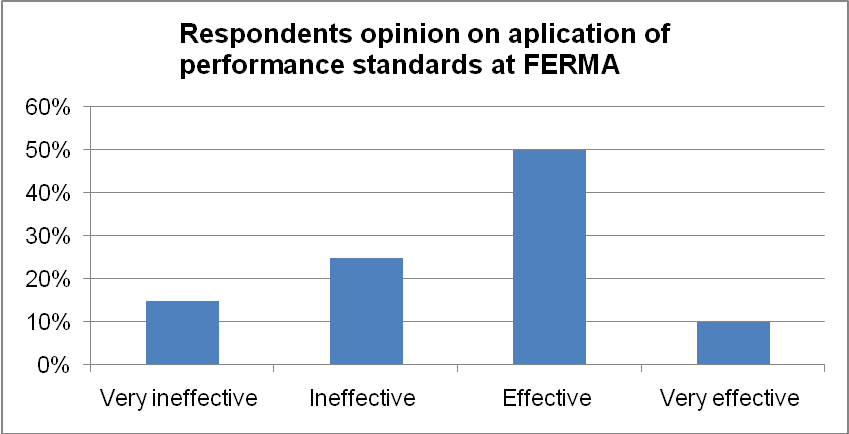
The rationale behind the application of performance standards is to eliminate ambiguity in the performance appraisal process. The standards form the baseline upon which performance appraisal is undertaken. Consequently, the supervisor can provide explicit feedback on the gap between the actual and expected performance. The effectiveness of the performance standards in the performance appraisal process can be evaluated by examining several guiding principles. The first principle involves examining the degree to which the standards enable employees to differentiate between unacceptable and acceptable performance results. Secondly, the standards must inform newly hired employees on performance expectations. The third principle entails increasing the employees’ level of job satisfaction because of the creation of knowledge of how successful the job tasks have been performed. The performance standards must be realistic and measurable.
Fifty-eight percent [58%] of the respondents are of the perception that the firm mainly uses the data gathered for employee promotion purposes. Conversely, 24% of the respondents argue that the firm does not disclose the purpose of the performance appraisal data while 12% of the respondents affirm that the data is used for APER forms. Only 6% of the respondents affirm that the data is used to establish the HR database. This shows that the firm has not appreciated the importance of communication in the performance appraisal process. This perception might adversely affect how the employees conduct themselves during the performance appraisal process. For example, some employees might not collaborate in the improvement of the performance appraisal standards. Bhattacharyya (2011, p. 7) affirms that to ‘gain acceptance from the employees, organisations prefer to develop performance standards collaboratively’. FERMA should ensure that the employees are duly informed of the purpose of the appraisal. This will promote the employee’s level of participation and acceptability of the process.
To improve the employees’ perception of the performance appraisal, FERMA should consider redesigning its performance appraisal system by incorporating different elements. Some of the elements that should be factored in the appraisal system include salary improvement, setting targets, evaluation of task completion, and continuous recording of employee performance as opposed to yearly performance reviews. The incorporation of these aspects is likely to contribute to significant improvement in the value of a performance appraisal. To improve the ease of the performance appraisal process, FERMA utilizes a uniform tool in gathering performance data. Using a uniform tool improves the ease with which the performance appraisal process is undertaken.
The responses obtained show that the appraisal system is not tied to the Agency’s commitment to employee retention, recruitment, and organizational culture. This aspect arises from the fact that the firm uses a generalized performance appraisal system that is used by other government departments. To improve the value of the appraisal system in the firm’s employee retention, recruitment, and organizational culture development efforts, FERMA should consider developing a performance appraisal system that is tailored to its operation. This move will ensure that the appraisal system is aligned with the firm’s organizational and employee development needs.
The study further highlights the existence of gaps in the integration of communication within the firm’s performance appraisal process. Sixty-eight percent (68%) of the respondents affirm that the firm has not appreciated the value of the dialogue in the performance appraisal process. Only 25% of the respondents recognize the existence of dialogue while 6.25% of the respondents do not have an idea on the establishment and sustenance of dialogue in the firm.
Table 8.
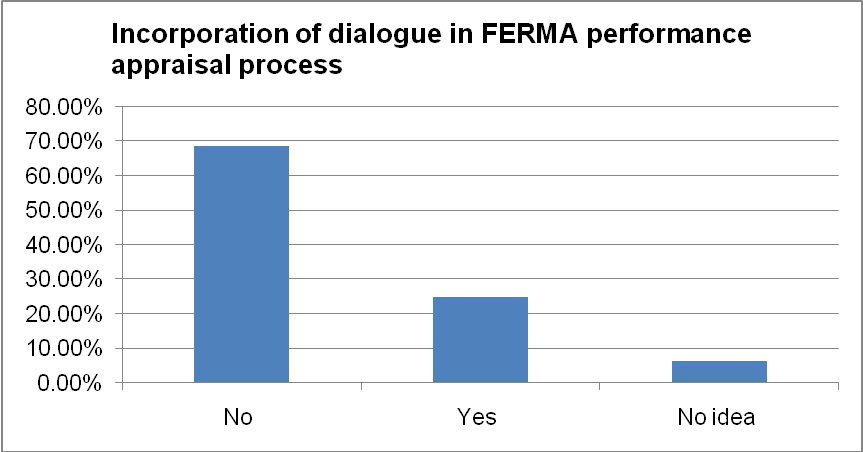
Graph 8 highlights the existence of a significant dialogue gap within the firm’s performance appraisal process. Nixon (2012) accentuates that dialogue in the performance appraisal process can contribute to the generation of valuable ideas hence promoting the likelihood of achieving personal and organizational growth. Nixon (2012, p. 234) further affirms that ‘performance management dialogues achieve the best results when both the appraiser and appraisee receive guidance on how the meeting(s) will be conducted and what to do when various sensitive topics arise’. The dialogue should be inclusive, which means that it should not discriminate against certain categories of employees. In addition to the lack of dialogue, the FERMA performance appraisal program has not entrenched the concept of feedback. Seventy-five percent (75%) of the respondents affirmed that FERMA does not provide them with feedback on the performance appraisal results.
Table 9.
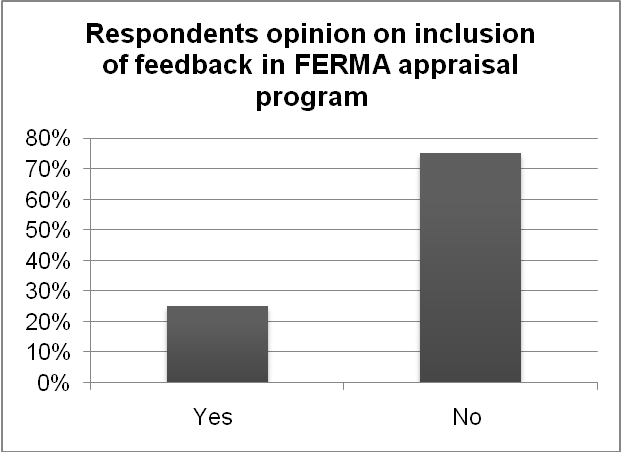
To improve the effectiveness of the performance appraisal process, the organization’s managers need to ensure that the employees are duly provided with the performance appraisal results. This aspect is essential in providing employees an opportunity to assess their performance. FERMA can improve the provision of performance appraisal results by developing an effective internal communication mechanism. To improve the effectiveness of the feedback provision process, the Agency should take into consideration several issues. First, the Agency should ensure that the party charged with the responsibility of providing the performance results is qualified and credible. This aspect will minimize the probability of employees denying the appraisal results. Moreover, the appraisal results should be timely provided to improve the probability of the employees making the requisite behavioral changes that are essential for performance improvement.
The study underlines that FERMA has failed to appreciate the value of the performance appraisal system in promoting employee job satisfaction and motivation. The respondents argued that the firm has not established a link between the performance appraisal system and employee retention. Nixon (2012) argues that the performance appraisal system should be used as a tool for strengthening the rate of employee retention. Achieving this requires the firm to foster organizational identification amongst employees, which is possible by nurturing a high level of employee motivation and job satisfaction. One of the critical aspects that the firm’s management team should take into consideration entails investing in employee training.
Conclusion
Although FERMA has recognized the performance appraisal system as an essential human resource management tool, its application within the firm has not been effective. This assertion arises from the identification of critical gaps in the application of the performance appraisal system. One of the notable gaps entails the failure to ensure a sufficient level of inclusiveness across the different organizational departments. Additionally, the firm has failed to provide employees with feedback on the performance results. Therefore, the application of the performance appraisal process does not appreciate the importance of the appraisal system as a tool for providing employees a sense of direction on the organization’s commitment to employee and organizational development. On the contrary, FERMA has largely applied the performance appraisal system as a human resource management formality. For example, the firm largely uses the performance appraisal system as a tool for employee promotion. The study shows the utilization of the tool in formulating employee development initiatives such as employee training.
The performance appraisal process should be used as a tool for achieving three main goals that include employee development, effective program, and administrative assessment. Concerning administrative purposes, the performance appraisal system should be used in improving the organization’s capacity to make rational decisions on human resource management such as employee training, transfers, promotions, and demotions. Therefore, the effective application of the performance appraisal process will contribute to remarkable improvement in FERMA’s capacity to undertake the assigned roles and responsibilities.
References
Aggarwal, A & Thakur, M, “Techniques of Performance Appraisal; A Review”, International Journal of Engineering and Advanced Technology, vol. 2, no. 3, (2013) pp. 618-623.
Agbola, Ruby and Sumalia, Abena, “The Effectiveness of Performance Appraisal As A Tool For Enhancing Employee Performance In The Public Health Sector” Global Management Journal 3.4 (2011): pp. 81-92.
Armstrong, Michael, “Armstrong’s Handbook Of Performance Management; An Evidence Based Guide”, New York: Kogan Page, 2009.
Arthur, Diane, “Performance Appraisals: Strategies For Success”, New York: American Management Association, 2008.
Ayers, Rebecca. “Aligning Individual And Organizational Performance: Goal Alignment Agency Performance Appraisal Program.” Public Personnel Management 44 (2015): pp. 169-191.
Bednall, Timothy, Karin Sanders, and Piety Runhaar, “Stimulating Informal Learning Activities Through Perceptions Of Performance Appraisal Quality And Human Resource Management System Strength; A Two Wave Study.” Academy of Management Learning & Education 13.1 (2014): 45-61.
Bhattacharyya, Kumar,” Performance Management Systems And Strategies”, Delhi: Pearson, 2011.
Bussin, M, “The Performance Management Handbook For Emerging Markets; A Practical And Informative Handbook For Managing Performance For The World Of Work In Emerging Markets, Knowres Publishing, New York, 2012.
Charles, Eyo. Nigeria; Redundancy Affects Ferma Staff In Calabar. Web.
Connaway, L & Powell, R., “Basic Research Methods For Librarians”, Libraries Unlimited, Santa Barbara, 2010.
Crowther, D & Lancaster, G., “Research Methods”, Routledge, New York, 2012.
Falcone, Paul and Tan, Winston, “The Performance Appraisal Tool Kit: Redesigning Your Performance Review Template To Drive Individual And Organizational Change”, New York: AMACOM, 2013.
Farndale, Elaine, and Clare Kelliher. “Implementing Performance Appraisal: Exploring The Employee Experience.” Human Resource Management 52.6 (2013): 879-897.
French, Ray. Organizational behaviour, Hoboken: Wiley, 2011.
Hepper, P, Wampold, B, Owen, J &Mindi T, “Research Design In Counselling”, Cengage Learning, New York, 2015.
Hernandez, S, “Strategic Human Resource Management In Health Services Organisations”, Delmar Cengage Learning, Clifton, 2010.
International Management Association: Wiley Cma Learning System Exam Review 2012. Wiley, Hoboken.
Kirkpatrick, Donald, “Improving Employee Performance Through Appraisal And Coaching”, New York: American Management Association, 2006.
Kondarasuk, Jack. “The Ideal Performance Appraisal Is A Format, Not A Form” Academy of Strategy Management10.1 (2011): 61-75.
Latham, Gary, “New Developments In Goal Setting And Task Performance”, New York: Routledge, 2013.
Lyster, Stephanie, and Anne Arthur, “199 Pre-Written Employee Performance Appraisals: The Complete Guide To Successful Employee Evaluations And Documentation”, Ocala: Atlantic Publishers, 2007.
Majumdar, R, “Marketing Research; Text, Application And Case Studies”, New Age International, New Delhi, 2011.
Mello, Jeffrey, “Strategic Human Resource Management”, Australia: Cengage, 2014.
Nixon, P, “Dialogue gap; why communication is not enough and what we can do about it fast”, John Wiley & Sons, Hoboken, 2012.
OECD: Performance Related Pay Policies For Governments’ Employees, Paris: OECD, 2005.
Ogunleye, Sola. “Towards Performance Measures Of Transportation Networks In Nigeria: Lessons From The Developed Countries.” Journal of Natural Sciences Research 3.7 (2013): 11-15.
Olatunji, Ayo, and IkechukwuDiugwu. “A Project Management Perspective To The Management Of Federal Roads In Nigeria; A Case Study Of Minna-Bida Road.” Science and Education Publishing 1.4 (2011): 1-6.
Qureshi, Amber, and Mubashir. “Impact Of Performance Appraisal Management On The Organizational Performance; An Analytical Investigation Of The Business Model Of McDonalds.” The International Journal of Academic Research in Economics and Management Sciences 2.5(2013): 54-73.
Remenyi, D, “Field Methods For Academic Research; Interviews, Focus Group And Questionnaires”, Academic Conference Limited, Chicago, 2012.
Schultz, D & Schultz, E, “Psychology and work today”, Routledge, New York, 2015.
Selvarajan, Thomas, and Peggy, Cloninger, “Can Performance Appraisal Motivate Employees To Improve Performance? A Mexican study.” The International Journal of Human Resource Management 23.15(2012): 3063-3084.
Streubert, H & Carpenter, D, “Qualitative Research In Nursing; Advancing The Humanistic Imperative”, Wolters Kluwer Health, Philadelphia, 2011.
Tappen, R, “Advanced Nursing Research; From Theory To Practice”, Jones & BartlettLearning, Sudbury, 2011.
Vallabhaneni, S, “Wiley Cia Exam Review, Internal Audit Knowledge Elements”, John Wiley, Hoboken, New Jersey, 2013.
